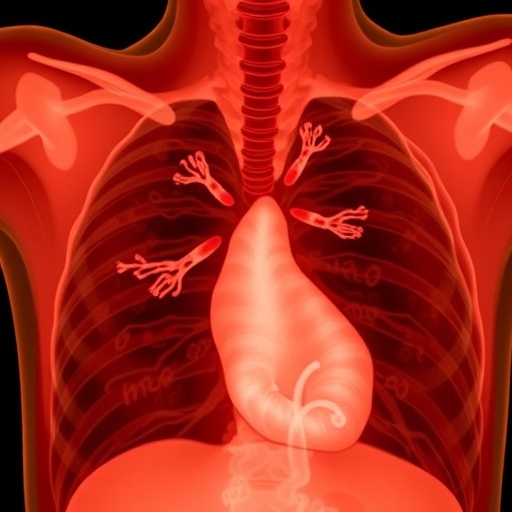In recent medical literature, a perplexing case has emerged that brings to light the complexity and diagnostic challenges inherent in pediatric respiratory conditions. The case, detailed in a 2025 publication in World Journal of Pediatrics, highlights a young patient suffering from a persistent cough accompanied by an unexplained endobronchial mass. This phenomenon has provoked renewed interest in the mechanisms underlying chronic coughs in children, particularly when traditional diagnostic pathways fail to reveal a clear cause. The case serves as a crucial reminder of the need for thorough investigation when common symptoms mask more sinister pathology.
Chronic cough in pediatric patients is a frequent complaint that mandates careful evaluation. Typically, causes range from benign conditions such as viral upper respiratory infections and asthma to more obscure and hazardous etiologies including structural airway abnormalities and neoplasms. The patient in this study presented with a relentless cough that failed to respond to standard medical therapies, prompting clinicians to pursue advanced diagnostic techniques. The persistent nature of the cough over weeks raised red flags, necessitating the use of bronchoscopy to visualize the airways directly.
Bronchoscopy remains the gold standard for assessing endobronchial lesions that are not easily characterized by imaging alone. In this reported case, the procedure uncovered a mass lesion obstructing part of the bronchial tree. Such masses are rare in pediatric populations and can represent a spectrum of pathologies from benign tumors, inflammatory pseudotumors, to malignancies like carcinoid tumors or lymphoma. The visualization of the mass was just the first step; subsequent biopsy and histopathological analysis were essential to define its nature conclusively.
Histopathology revealed complex cellular organization consistent with a rare benign lesion. These benign endobronchial masses, though non-malignant, can cause significant morbidity due to airway obstruction. The presence of the mass explains the chronic cough through mechanical irritation and partial airway obstruction leading to impaired mucus clearance and secondary inflammation. This highlights the intricate relationship between structural airway pathology and clinical symptomatology.
The management of such cases involves multidisciplinary collaboration, weighing the risks and benefits of surgical removal versus conservative management. Given the patient’s age and the lesion’s location, a minimally invasive bronchoscopic resection was pursued. Advances in pediatric bronchoscopy techniques including laser resection and cryotherapy have paved the way for removing airway obstructions with reduced morbidity compared to open surgery. Postoperatively, the patient’s symptoms resolved, confirming the causative role of the mass in the chronic cough.
This case exemplifies the critical importance of integrating radiological, bronchoscopic, and pathological data to establish accurate diagnoses in pediatric airway disorders. Standard imaging modalities such as chest X-rays often fail to detect small or centrally located endobronchial masses, thereby delaying diagnosis. Computed tomography (CT) and magnetic resonance imaging (MRI), while more sensitive, can still miss lesions without clear contrast enhancement patterns or in complex anatomical regions. Thus, bronchoscopy’s direct visualization remains indispensable.
From a pathophysiological standpoint, the persistence of cough despite initial therapy underscores the role of local airway obstruction and irritation in generating the cough reflex. The cough reflex arc involves sensory nerve fibers within the airway mucosa, which, when stimulated by mechanical or chemical irritants, triggers an involuntary protective response. Chronic irritation by a mass lesion perpetuates this reflex, resulting in non-resolving symptoms that mimic chronic bronchitis or asthma.
The implications of this case extend beyond clinical diagnosis and treatment; they prompt a reevaluation of pediatric cough management guidelines. While most cases of persistent cough in children are benign and self-limited, the potential for underlying structural abnormalities necessitates vigilance. Clinicians must maintain a high index of suspicion for atypical causes when cough persists beyond typical durations, especially when accompanied by localized wheezing or recurrent pneumonias.
Moreover, this report underlines the need for improved educational resources and awareness among health care providers regarding rare pediatric airway conditions. Delayed diagnosis not only prolongs patient suffering but increases the risk of complications such as irreversible airway damage or secondary infections. Early referral to specialized centers with pediatric bronchoscopic capabilities is vital for timely intervention.
Advancements in molecular diagnostics may also revolutionize the approach to such cases in the future. Emerging techniques including next-generation sequencing of biopsy samples and biomarker profiling hold promise in differentiating benign from malignant lesions without necessitating extensive surgical procedures. These innovations could reduce diagnostic delays and optimize personalized treatment plans.
In the broader context of pediatric pulmonology research, this unusual presentation encourages the exploration of novel pathomechanisms that might contribute to endobronchial mass formation. Genetic predispositions, chronic inflammatory states, and environmental exposures may interplay in ways not yet fully understood. Establishing comprehensive registries and conducting multicenter studies will be essential to unravel these complexities and improve patient outcomes.
Clinicians should also consider the psychosocial impact on patients and families dealing with unexplained persistent symptoms. Chronic cough significantly affects quality of life, interrupting sleep, school attendance, and social interactions. Multidisciplinary care teams including respiratory therapists, psychologists, and pediatricians must address these broader aspects alongside physical health.
From a technological perspective, the evolution of imaging and interventional bronchoscopy tools will continue to shape the diagnostic and therapeutic landscape. High-resolution imaging, virtual bronchoscopy, and robotic-assisted procedures promise increased safety and efficacy. As these tools become more accessible, the threshold for investigating persistent pediatric cough with invasive techniques may lower, enabling earlier detection of anomalies.
In conclusion, the case of a persistent cough caused by an unexplained endobronchial mass, as detailed by Ye et al., presents a compelling narrative about diagnostic perseverance and interdisciplinary collaboration. It challenges clinicians to think beyond common etiologies, advocating for comprehensive workups when faced with recalcitrant symptoms. This approach not only resolves individual cases but also enriches our collective understanding of pediatric airway diseases.
Ultimately, advancing pediatric respiratory care will depend on integrating clinical acumen with cutting-edge biomedical innovations. By sharing detailed case reports and analyses, the medical community can accelerate progress towards more precise, less invasive, and more effective approaches to managing challenging respiratory conditions in children. The lessons learned from rare cases such as this resonate widely, emphasizing that even the most familiar symptoms warrant careful and thorough evaluation.
Subject of Research: Pediatric Persistent Cough Associated with Unexplained Endobronchial Mass
Article Title: Persistent cough with unexplained endobronchial mass
Article References:
Ye, B., Luo, CN., Xu, HB. et al. Persistent cough with unexplained endobronchial mass. World J Pediatr (2025). https://doi.org/10.1007/s12519-025-00975-7
Image Credits: AI Generated
DOI: https://doi.org/10.1007/s12519-025-00975-7
Tags: advanced diagnostic techniquesairway abnormalities in childrenbronchoscopy in pediatricschronic cough evaluationcomplex respiratory pathologyendobronchial mass diagnosismedical literature on coughpediatric neoplasmspediatric respiratory conditionspersistent cough in childrenrespiratory symptoms investigationunexplained pediatric cough





